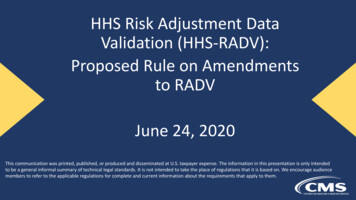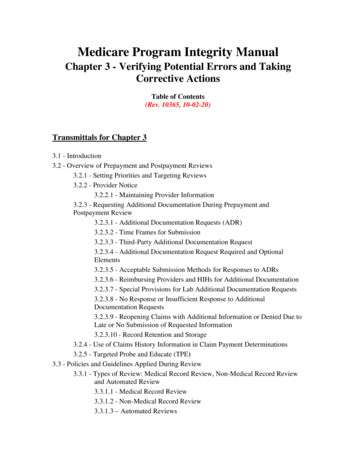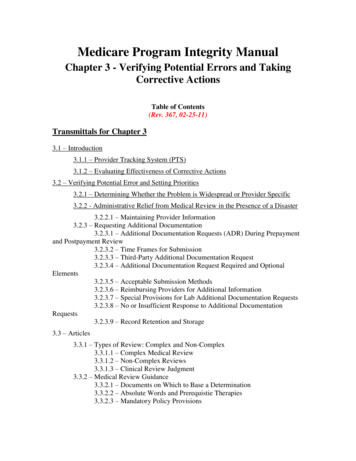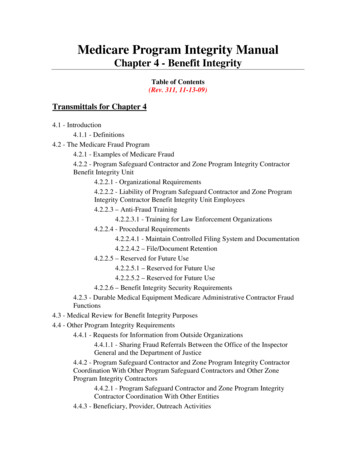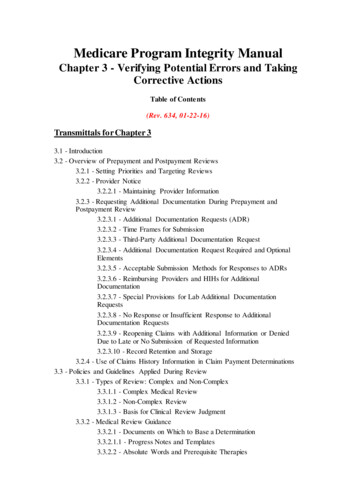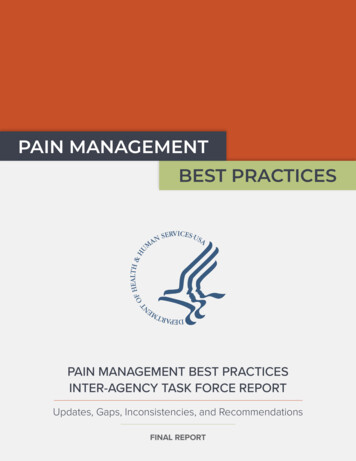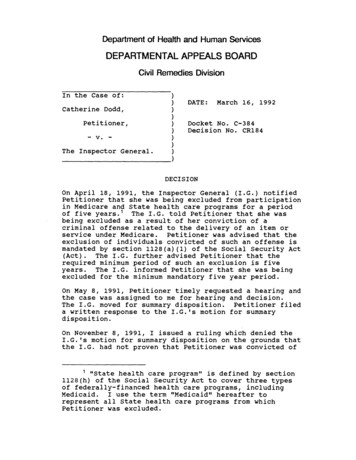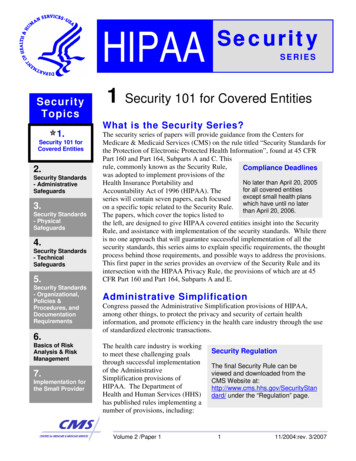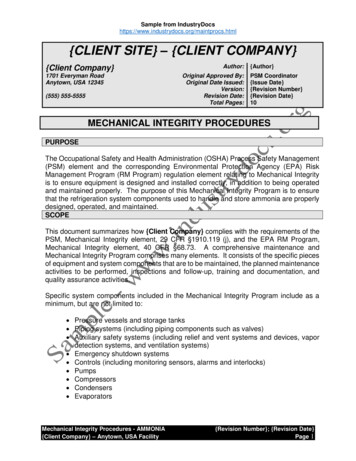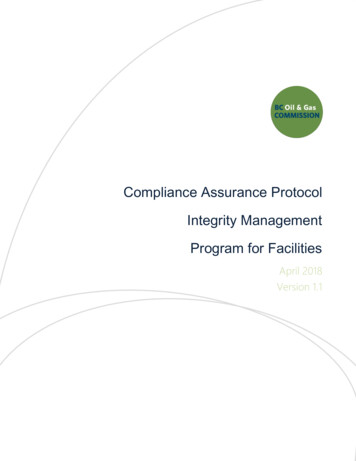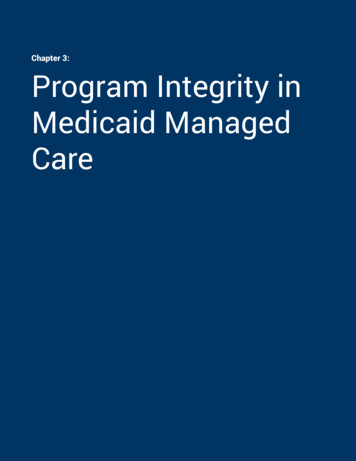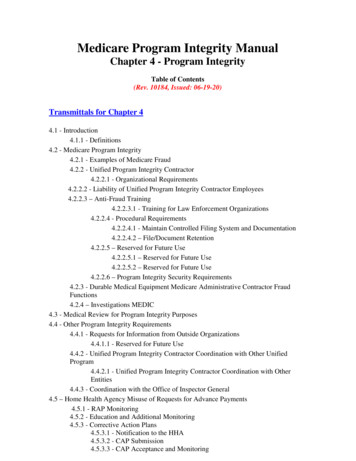
Transcription
Medicare Program Integrity ManualChapter 4 - Program IntegrityTable of Contents(Rev. 10184, Issued: 06-19-20)Transmittals for Chapter 44.1 - Introduction4.1.1 - Definitions4.2 - Medicare Program Integrity4.2.1 - Examples of Medicare Fraud4.2.2 - Unified Program Integrity Contractor4.2.2.1 - Organizational Requirements4.2.2.2 - Liability of Unified Program Integrity Contractor Employees4.2.2.3 – Anti-Fraud Training4.2.2.3.1 - Training for Law Enforcement Organizations4.2.2.4 - Procedural Requirements4.2.2.4.1 - Maintain Controlled Filing System and Documentation4.2.2.4.2 – File/Document Retention4.2.2.5 – Reserved for Future Use4.2.2.5.1 – Reserved for Future Use4.2.2.5.2 – Reserved for Future Use4.2.2.6 – Program Integrity Security Requirements4.2.3 - Durable Medical Equipment Medicare Administrative Contractor FraudFunctions4.2.4 – Investigations MEDIC4.3 - Medical Review for Program Integrity Purposes4.4 - Other Program Integrity Requirements4.4.1 - Requests for Information from Outside Organizations4.4.1.1 - Reserved for Future Use4.4.2 - Unified Program Integrity Contractor Coordination with Other UnifiedProgram4.4.2.1 - Unified Program Integrity Contractor Coordination with OtherEntities4.4.3 - Coordination with the Office of Inspector General4.5 – Home Health Agency Misuse of Requests for Advance Payments4.5.1 - RAP Monitoring4.5.2 - Education and Additional Monitoring4.5.3 - Corrective Action Plans4.5.3.1 - Notification to the HHA4.5.3.2 - CAP Submission4.5.3.3 - CAP Acceptance and Monitoring
4.5.3.4 - CAP Closeout4.5.4 - RAP Suppression4.5.4.1 - Notice of RAP Suppression4.5.4.2 - Monitoring During RAP Suppression4.5.4.3 - Result of Initial RAP Suppression Monitoring Period4.5.4.3.1 - Reinstatement of RAP Authorization4.5.4.3.2 - Continuation of RAP Suppression4.5.5 - Coordination and Referral to the UPIC4.6 - Complaints4.6.1 - Definition of a Complaint4.6.2 - Complaint Screening4.6.2.1 – Contact Center Operations4.6.2.2 – OIG Hotline4.6.2.3 – MAC Complaint Screening4.6.2.4 – Referrals to the UPIC4.6.2.5 – UPIC and I-MEDIC Responsibilities4.6.3 – Screening Leads4.6.4 - Vetting Leads with CMS4.7 - Investigations4.7.1 - Conducting Investigations4.7.2 – Closing Investigations4.8 - Disposition of Cases Referred to Law Enforcement4.8.1 – Reversed Denials by Administrative Law Judges on Open Cases4.8.2 - Production of Medical Records and Documentation for an Appeals Case File4.9 - Incentive Reward Program4.9.1 - UPIC Responsibilities for the Incentive Reward Program4.9.2 - Guidelines for Processing Incoming Complaints4.9.3 - Guidelines for Incentive Reward Program Complaint Tracking4.9.4 - Excluded Individuals4.9.5 - Amount and Payment of Reward4.9.6 - Unified Program Integrity Contractor Responsibilities4.9.6.1 - Guidelines for Processing Incoming Complaints4.9.6.2 - Guidelines for IRP Complaint Tracking4.9.6.3 - Overpayment Recovery4.9.6.4 - Eligibility Notification4.9.6.5 - Incentive Reward Payment4.9.6.6 - Reward Payment Audit Trail4.9.7 - CMS Incentive Reward Winframe Database4.9.8 - Updating the Incentive Reward Database4.10 - Fraud Alerts4.10.1 - Reserved for Future Use4.10.2 - Reserved for Future Use
4.10.3 - Reserved for Future Use4.10.4 - Reserved for Future Use4.10.5 - Reserved for Future Use4.12 - Unified Case Management System4.12.1 – Initial Entry and Update Requirements for UPIC Initiated Projects4.12.2 - Initial Entry and Update Requirements for UPIC Leads and Investigations4.12.3 - Initial Entry and Update Requirements for RFIs/RFAs4.12.4 - Initial Entry and Update Requirements for LE Payment SuspensionRequests4.12.5 - Update Requirements for Immediate Advisements4.12.6 - Attaching Documents and Files in the UCM4.12.7 - Duplicate Entries4.12.8 - Deleting Entries in the UCM4.12.9 - UCM Helpdesk4.13 - Administrative Relief from Program Integrity Review in the Presence of a Disaster4.14 - Provider/Supplier Contacts by the UPIC4.15 - Case Coordination with UPICs4.16 – MAC and UPIC Coordination on Voluntary Refunds4.17 – Reserved for Future Use4.18 - Referral of Cases to Other Entities for Action4.18.1 - Referral of Cases to the OIG/OI4.18.1.1 - Reserved for Future Use4.18.1.2 - Immediate Advisements to the OIG/OI4.18.1.3 - Payment Suspension4.18.1.3.1 - Suspension4.18.1.3.2 - Denial of Payments for Cases Referred to and Acceptedby OIG/OI4.18.1.3.3 - Recoupment of Overpayments4.18.1.4 - OIG/OI Referral and Summary Report4.18.1.5 - Referral to Other Law Enforcement Agencies4.18.1.5.1 - Continue to Monitor Provider and Document Case File4.18.1.5.2 - Take Administrative Action on Cases Referred to andDeclined/Returned by OIG/OI4.18.1.5.3 - Refer to Other Law Enforcement Agencies4.18.2 - Referral to State Agencies or Other Organizations4.18.3 – ZPICs and QIOs4.18.4 – Referral of Cases to the MAC4.19 - Administrative Sanctions4.19.1 - Unified Program Integrity Contractor’s and Medicare AdministrativeContractor’s Role4.19.2 - Authority to Exclude Practitioners, Providers, and Suppliers of Services4.19.2.1 - Basis for Exclusion Under §1128(b)(6) of the Social Security Act4.19.2.2 - Identification of Potential Exclusion Cases4.19.2.3 - Development of Potential Exclusion Cases
4.19.2.4 - Contents of Sanction Recommendation4.19.2.5 - Notice of Administrative Sanction Action4.19.2.5.1 - Notification to Other Agencies4.19.2.6 - Denial of Payment to an Excluded Party4.19.2.6.1 - Denial of Payment to Employer of Excluded Physician4.19.2.6.2 - Denial of Payment to Beneficiaries and Others4.19.3 - Appeals Process4.19.4 - Reinstatements4.19.4.1 - Monthly Notification of Sanction Actions4.20 - Civil Monetary Penalties4.20.1 - Background4.20.1.1 - Basis of Authority4.20.1.2 - Purpose4.20.1.3 - Enforcement4.20.1.4 - Administrative Actions4.20.1.5 - Documents4.20.2 - Civil Monetary Penalty Authorities4.20.2.1 - Civil Monetary Penalties Delegated to CMS4.20.2.2 - Civil Monetary Penalties Delegated to OIG4.20.3 - Referral Process4.20.3.1 - Referral Process to CMS4.20.3.2 - Referrals to OIG4.20.4 - CMS Generic Civil Monetary Penalty Case Contents4.20.5 - Additional Guidance for Specific Civil Monetary Penalties4.20.5.1 - Beneficiary Right to Itemized Statement4.20.5.2 - Medicare Limiting Charge Violations4.21 - Monitor Compliance4.21.1 - Resumption of Payment to a Provider - Continued Surveillance AfterDetection of Fraud4.22 - Discounts, Rebates, and Other Reductions in Price4.22.1 - Anti-Kickback Statute Implications4.22.1.1 - Marketing to Medicare Beneficiaries4.22.2 - Cost-Based Payment (Intermediary and MAC Processing of Part A Claims):Necessary Factors for Protected Discounts4.22.3 - Charge-Based Payment (MAC Processing of Part B Claims): NecessaryFactors for Protected Discounts4.22.4 - Risk-Based Provider Payment: Necessary Factors for Protected Discounts4.23 - Identity Theft – Investigations and Victimized Provider Waiver of Liability Process4.24 - Reserved for Future Use4.25 - Participation Agreement and Limiting Charge Violations4.26 - Supplier Proof of Delivery Documentation Requirements4.26.1 - Proof of Delivery and Delivery Methods
4.26.2 – Exceptions4.26.3 Proof of Delivery Requirements for Recently Eligible Medicare FFSBeneficiaries4.27 – Reserved for Future Use4.28 - Joint Operating Agreement4.29 - Reserved for Future Use4.30 – Reserved for Future Use4.31 – Vulnerabilities4.32 - Reserved for Future Use4.33 – UPIC Coordination with Other Contractors (RAC) Related to the RAC DataWarehouse4.34 - Suppression and/or Exclusion – Examples
4.1 - Introduction(Rev. 902, Issued: 09-27-19, Effective: 10-28-19, Implementation: 10-28-19)CMS Pub. 100-08, Program Integrity Manual (PIM), reflects the principles, values, andpriorities of the Medicare Integrity Program (MIP). The primary principle of programintegrity (PI) is to pay claims correctly. To meet this goal, Unified Program IntegrityContractors (UPICs), Supplemental Medical Review Contractors (SMRC) and MedicareAdministrative Contractors (MACs) must ensure that Medicare pays the right amount forcovered and correctly coded services rendered to eligible beneficiaries by legitimateproviders. The focus of the UPICs, SMRCs and MACs shall be to ensure compliance withMedicare regulations, refer suspected fraud and abuse to our Law Enforcement (LE)partners, and/or recommend revocation of providers that are non-compliant with Medicareregulation and policies. The Centers for Medicare & Medicaid Services (CMS) followsfour parallel strategies in meeting this goal:1. Prevent fraud through effective enrollment and education of providers/suppliersand beneficiaries;2. Encourage early detection (through, for example, the Fraud PreventionSystem (FPS), medical review (MR) and data analysis);3. Coordinate closely with partners, including other UPICs, SMRCs, MACs, LEagencies, and State PI units; and4. Enact fair and firm enforcement policies.The UPICs shall follow the PIM to the extent outlined in their respective task orders’Statement of Work (SOW). The UPICs shall only perform the functions outlined in thePIM as they pertain to their own operation. The UPICs, in partnership with CMS, shall beproactive and innovative in finding ways to enhance the performance of PIM guidelines.For this entire chapter, any reference to UPICs shall also apply to the InvestigationsMedicare Drug Integrity Contractor (I-MEDIC), unless otherwise noted or identified in theContractors’ SOW. MACs shall follow the PIM in accordance with their SOW.4.1.1 - Definitions(Rev. 675, Issued: 09-09-16, Effective: 12-12-16, Implementation: 12-12-16)To facilitate understanding, the terms used in the PIM are defined in PIM Exhibit 1. Theacronyms used in the PIM are listed in PIM Exhibit 23.4.2 - The Medicare Program Integrity(Rev. 902, Issued: 09-27-19, Effective: 10-28-19, Implementation: 10-28-19)This section applies to UPICs, SMRCs and MACs, as indicated.The primary goal of the UPIC is to identify cases of suspected fraud, waste and abuse,develop them thoroughly and in a timely manner, and take immediate action to ensure thatMedicare Trust Fund monies are not inappropriately paid. Payment suspension and denialof payments and the recoupment of overpayments are examples of the actions that may betaken in cases of suspected fraud. Once such actions are taken, cases where there is
potential fraud are referred to LE for consideration and initiation of criminal or civilprosecution, civil monetary penalties (CMP), or administrative sanction actions.Preventing and detecting fraud, waste, and abuse involves a cooperative effort amongbeneficiaries; UPICs; SMRCs; MACs; providers/suppliers; quality improvementorganizations (QIOs); and federal agencies such as CMS; the Department of Health andHuman Services (DHHS); the Office of Inspector General (OIG); the Federal Bureau ofInvestigation (FBI); and the Department of Justice (DOJ).Each investigation is unique and shall be tailored to the specific circumstances. Theseguidelines are not to be interpreted as requiring the UPIC to follow a specific course ofaction or establish any specific requirements on the part of the government or its agentswith respect to any investigation. Similarly, these guidelines shall not be interpreted ascreating any rights in favor of any person, including the subject of an investigation. Whenthe UPIC makes the determination of potential fraud, waste, and/or abuse, the UPIC shalleffectuate all appropriate administrative actions and refer the case to LE, if appropriate.When the UPIC makes the determination that a matter is not potential fraud, waste, and/orabuse, the UPIC shall close the matter, or de-escalate the matter to the appropriate unit atthe MAC, QIO, or other entity, when appropriate.4.2.1 - Examples of Medicare Fraud(Rev. 902, Issued: 09-27-19, Effective: 10-28-19, Implementation: 10-28-19)This section applies to UPICs, SMRCs and MACs.The most frequent kind of fraud arises from a false statement or misrepresentation made,or caused to be made, that is material to entitlement or payment under the Medicareprogram. The violator may be a provider/supplier, a beneficiary, an employee of aprovider/supplier, or some other person or business entity, including a billing service or acontractor employee.Providers/suppliers have an obligation, under law, to conform to the requirements of theMedicare program. Fraud committed against the program may be prosecuted undervarious provisions of the United States Code and could result in the imposition ofrestitution, fines, and, in some instances, imprisonment. In addition, a range ofadministrative sanctions (such as exclusion from participation in the program) and CMPsmay be imposed when facts and circumstances warrant such action.Fraud may take such forms as (this is not an exhaustive list): Incorrectreporting of diagnoses or procedures to maximize payments; Billing for services not furnished and/or supplies not provided. This includesbilling Medicare for appointments that the patient failed to keep; Billing thatappears to be a deliberate application for duplicate payment for thesame services or supplies, billing both Medicare and the beneficiary for the sameservice, or billing both Medicare and another insurer in an attempt to get paidtwice;
Alteringclaim forms, electronic claim records, medical documentation, etc., toobtain a higher payment amount; Soliciting, offering, or receiving a kickback, bribe, or rebate (e.g., paying for areferral of patients in exchange for the ordering of diagnostic tests and otherservices or medical equipment); Unbundling or“exploding” charges; Completing Certificates of Medical Necessity for patients not personally andprofessionally known by the provider; Participating in schemes that involve collusion between a provider and abeneficiary, or between a supplier and a beneficiary; Participating inschemes that involve collusion between a provider and a MACemployee where the claim is assigned (e.g., the provider deliberately overbills forservices, and the MAC employee then generates adjustments with little or noawareness on the part of the beneficiary); Billing basedon “gang visits,” (e.g., a physician visits a nursing home and billsfor 20 nursing home visits without furnishing any specific service to individualpatients); Misrepresenting datesand descriptions of services furnished or the identity ofthe beneficiary or the individual who furnished the services; Billing non-coveredor non-chargeable services as covered items; Repeatedly violating the participation agreement, assignment agreement, or thelimitation amount; Knowingly allowing a beneficiary to use another person's Medicare card toobtain medical care; Giving false information Using theabout provider ownership; oradjustment payment process to generate fraudulent payments.Examples of cost report fraud include (this is not an exhaustive list): Incorrectly apportioning Includingcosts on cost reports;costs of non-covered services, supplies, or equipment in allowablecosts; Providersmaking arrangements with employees, independent contractors,suppliers, and others that appear to be designed primarily to overcharge theprogram through various devices (commissions, fee splitting) to siphon off orconceal illegal profits;
Billing Medicarefor costs that were not incurred or were attributable to nonprogram activities, other enterprises, or personal expenses; Repeatedly including unallowable cost items on a provider's cost report forpurposes of establishing a basis for appeal; Manipulating statisticsto obtain additional payment, such as increasing thesquare footage in the outpatient areas to maximize payment; Claiming baddebts without first genuinely attempting to collect payment; Making improper paymentsto physicians for certain hospital-based physicianarrangements; Paying amounts to owners or administrators that have been determined to beexcessive in prior cost report settlements; Reporting days Depreciatingimproperly that result in an overpayment if not adjusted;assets that have been fully depreciated or sold; Using depreciationmethods not approved by Medicare; Repaying interest expense for loans that were for an offset of interest incomeagainst the interest expense; Reporting programdata where provider program amounts cannot be supported; Allocatingcosts improperly related to organizations that have beendetermined to be improper; or Manipulating accounting4.2.2 - Unified Program Integrity Contractor(Rev. 902, Issued: 09-27-19, Effective: 10-28-19, Implementation: 10-28-19)This section applies to UPICs.The UPIC is responsible for preventing, detecting, and deterring fraud, waste, and abuse inboth the Medicare program and the Medicaid program. The UPIC: Preventsfraud by identifying program vulnerabilities; Proactively identifies incidents of potential fraud, waste, and abuse that existwithin its service area and takes appropriate action on each case; Investigates(determines the factual basis of) allegations of fraud made bybeneficiaries, providers/suppliers, CMS, OIG, and other sources. Whenappropriate, the UPIC may collaborate with CMS, State Medicaid Agency(SMA), and MFCU personnel;
Exploresall available sources of fraud leads in its jurisdiction, including theSMA and the Medicaid Fraud Control Unit (MFCU); Initiatesappropriate administrative actions where there is reliable evidence offraud, including, but not limited to, payment suspensions and revocations; Referscases to the OIG/Office of Investigations (OI) for consideration of civiland criminal prosecution and/or application of administrative sanctions (seesection 4.18 of this chapter, as well as PIM, chapter 8); Refers any necessary provider/supplier and beneficiary outreach to the provideroutreach and education (POE) staff at the MAC; Initiatesand maintains networking and outreach activities to ensure effectiveinteraction and exchange of information with internal components as well asoutside groups; Partnerswith state Medicaid PI units to perform the above activities insuspected Medicaid fraud, waste, and abuse cases (including Medi-Medicases); or Works closely with CMS on joint projects, investigations and other proactive,anti-fraud activities.The UPIC is required to use a variety of techniques, both proactive and reactive, toaddress any potentially fraudulent, wasteful, or abusive billing practices based on thevarious leads they receive.Proactive leads are leads identified or self-initiated by the UPIC. Examples of proactiveleads include, but are not limited to: (1) UPIC data analysis that uncovers inexplicableaberrancies that indicate potentially fraudulent, wasteful, or abusive billing for specificproviders/suppliers; (2) the discovery of a new lead by a UPIC during a provider/supplieror beneficiary interview; and (3) the combining of information from a variety of sources tocreate a new lead. The UPIC shall pursue leads identified through data analysis (UPICsshall follow PIM Chapter 2, Section 2.3 for sources of data), the Internet, the Unified CaseManagement system (UCM), news media, industry workgroups, conferences, etc. Forworkload reporting purposes, the UPIC shall only identify as proactive thoseinvestigations and cases that the UPIC self-initiated.The UPIC shall take prompt action after scrutinizing billing practices, patterns, or trendsthat may indicate fraudulent billing, (i.e., reviewing data for inexplicable aberrancies andrelating the aberrancies to specific providers/suppliers, identifying “hit and run”providers/suppliers, etc.).Fraud leads from any external source (e.g., LE, CMS referrals, beneficiary complaints,and the FPS) are considered to be reactive and not proactive. However, taking ideas fromexternal sources, such as Fraud Alerts, and using them to look for unidentified aberrancieswithin UPIC data is proactive.4.2.2.1 - Organizational Requirements(Rev. 851, Issued: 12-14-18, Effective: 10-22-18, Implementation: 10-22-18)
This section applies to UPICs and MACs, as indicated.UP
CMS Pub. 100-08, Program Integrity Manual (PIM), reflects the principles, values, and priorities of the Medicare Integrity Program (MIP). The primary principle of program integrity (PI) is to pay claims correctly. To meet this goal, Unified Program Integrity Contractors (UPICs), Su
